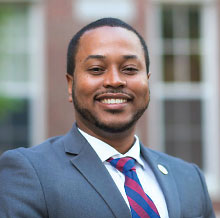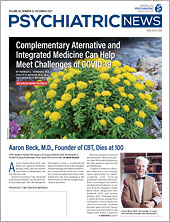Taking an economics framework and applying it to the delivery of mental health can help psychiatrists better connect with decision-makers to help drive key policies, an economics scholar said during a plenary session at APA’s virtual Mental Health Services Conference in October.
“It’s important to conceptualize mental health as a form of human capital because without it, people cannot do the work they need to do; they cannot be productive,” explained economist Peter Q. Blair, Ph.D., M.Sc., an assistant professor at the Harvard Graduate School of Education, co-director of the Project on Workforce, and principal investigator of Blair Economics Lab. “We want to think specifically and concretely about how to help and best serve those who are marginalized and experiencing severe symptoms. But we also want to think preemptively about mental health as a form of capital—that we need to invest in proactively or it will depreciate over time.”
Blair told attendees that while he was in graduate school, the global financial crisis of 2007-2008 occurred, triggered by a collapse of the housing market. He was struck at that time by the way the secretary of the Treasury convinced lawmakers and then-President Bush to authorize an $800 billion bailout for faltering U.S. financial institutions to keep the economy from collapsing. Blair was moved by the way economists took the stories of people who were struggling financially and losing their homes and translated them to connect with policymakers and generate action.
Blair believes that clinicians can similarly tell the stories of their patients to spur new public policy. “There’s something significant about this moment when it comes to mental health. We have a unique moment, given the confluence of the pandemic; Black Lives Matter; and highly successful, accomplished people coming forward and talking about their struggles with their mental health,” he said, referring to gymnast Simon Biles, tennis player Naomi Osaka, and actress and member of the British royal family Megan Markle.
Focus on Self-Care
Blair also talked about the importance of psychiatrists investing in their mental health in the same way they invest in continuing education through continuing coursework and in their physical health through exercise and regular checkups. “Mental health is a form of capital that depreciates, that we need to invest in, that we need to maintain and deal with preemptively before we get sick. We want to have a mental health approach that is proactive.” Session moderator and psychiatrist Sarah Y. Vinson, M.D., founder of the Lorio Psych Group and an associate clinical professor of psychiatry at Morehouse School of Medicine, said that shifting the profession’s focus to prevention would require some reimagining.
“In medicine as a whole, and in psychiatry too, there’s more of a focus on pathology, on illness, on diagnoses. There’s less of a focus on mental health maintenance. We don’t have a mental health care system; we have a mental sick care system. People don’t enter it until there’s a problem.” She said part of the profession’s challenge is a lack of resources to help all the people in need.
Work Is Key to Mental Health
Blair pointed out that mental health is about more than the mere absence of psychiatric symptoms; it also includes the ability to realize one’s capacity for agency and contribute to the larger society with dignity. He discussed the role of educational opportunity, occupational skill attainment, and meaningful employment as instrumental components to mental health. Blair pointed out that even among those with the most serious mental illness, most want to work. “For people with mental health challenges, having access to work can be a form of dignity that can itself be a form of treatment,” he said.
In economics people without college degrees are typically referred to as “unskilled,” whereas people with college degrees are referred to as “skilled,” Blair said. “What we saw during the pandemic is a lot of people we thought were unskilled were actually essential workers, and they were heroes. … We have to change the way we think about that labor.”
Blair said that “degree inflation,” or the growing requirement for college degrees as a condition of employment, poses a major barrier to economic mobility for members of minority groups. In an article Blair co-wrote, he pointed out that 67% of postings for new production supervisors in 2015 required bachelor’s degrees, despite just 16% of existing production supervisors having such degrees at the time. He wrote that unnecessary degree requirements embed into the labor market the legacy of Black exclusion from the U.S. education system. According to government data, just 25% of Black and 18% of Hispanic workers older than 25 have a college degree.
Blair is advocating for the hiring of 71 million rising STARS, or individuals with high school degrees or the equivalent who are Skilled Through Alternative Routes. The goal is to create a more inclusive workforce in which people with diverse backgrounds can enter, thrive, and build relationships.
Speaker Discusses Scope of Practice
Vinson asked Blair to discuss scope of practice issues, and he encouraged psychiatrists to think about the problem using the framework of DOCC: Who are the Decisionmakers? What is the Objective? What are the Choices? and what are the Constraints? The current constraints include the limited number of seats in medical schools, insufficient number of residency slots, and the massive student loan debt often incurred by today’s graduating physicians.
“If our objective is to exact as much money and stability from the current system as we can, that may lead to a different outcome than if the objective is population mental health and being able to cure more people,” Vinson said. “Is our role going to be as an administrator and supervisor, rather than providing direct clinical care? … If the goal is to help more people, it’s clear, given the gap between what we’re able to provide and what is needed, that something fairly radical needs to happen to bridge that gap.”
Blair called for an examination of these issues, encouraging attendees to ask themselves about their hopes and what drew them to the profession. “What are my highest hopes, what are my choices, and what are the constraints that are standing in my way from being able to do that? ... What if we all came together collectively? Could we all push back against some of those constraints or re-resource or reimagine those constraints and reduce them for all of us?” ■
More information is available
here.

